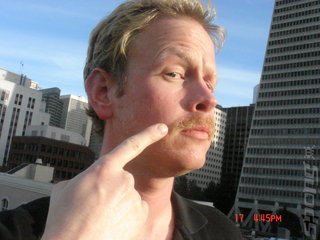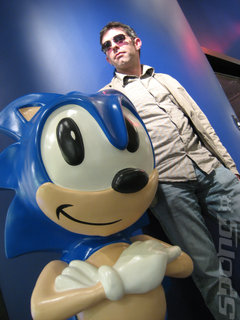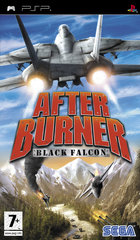Those of us who fondly remember watching Button Moon on television might also remember going to the local arcade to waste all their pocket money on the latest SEGA games available.
Arcades were a more important industry back then, kids these days on their PlayStation 3s and XBOX 360s are unlikely to have experienced the joy of sitting in a “real fighter cockpit” and charging through hordes of enemy planes in the hit game Afterburner. Yu Suzuki’s classic entertained many an 80’s child.
The series has been reborn on Sony's PSP after years of absence. The new arcade game, and now the PSP version. are worthy of a big grin from ear to ear for us in the SPOnG office. So, without much time-wasting, we spoke to Planet Moon Studios, the developers responsible for making the PSP's After Burner: Black Falcon as action-packed as AM2’s coin-guzzling counterpart.
SPOnG:Being the first time we’ve seen such a prestigious SEGA franchise in years, how much pressure is there to make Black Falcon as good as the originals played?
Ryan Kaufman (Project Lead & Lead Designer, Planet Moon): After Burner is obviously one of the classic games of the arcade, and we at Planet Moon all remembered it from our own misspent youth. So we naturally wanted to do the memory justice and bring the game into the modern era. The pressure helped to really focus our efforts on nailing that original experience, and I think we’ve really done it.
SPOnG: SEGA appears to enjoy outsourcing their intellectual property these days. Do you think this is ultimately a good thing?
Christopher Kaminski (Associate Producer, SEGA): Outsourcing. That’s an awfully emotionally charged word, don’t you think? Working with external development studios is totally standard practice in the games industry, both in the US and Japan. Planet Moon and SEGA have a great relationship, which is evidenced by the joint interview. Plus there’s some serious deep connections. Bob Stevenson, the Executive Producer on Black Falcon, worked on the After Burner II Genesis port.
SPOnG: Why has development of this Afterburner game not gone to AM2, developers of the original game? Have the original team worked with you in any way to help development of this title?
Christopher: AM2 had their hands full with the After Burner: Climax game when we made the decision to move on Black Falcon. They were a great help by providing us early looks at what they were doing, sharing titbits of information, helping us kick off great relationships with Boeing, Lockheed Martin, and Northrop Grumman… and they gave us one more thing… but that’s a secret.
SPOnG: How has your relationship been with SEGA during development of this game? Have they been overly protective of the IP or are they giving you a bit of creative freedom?
Ryan: SEGA has been great with us. We all talked a lot early on about what a new After Burner game would feel like, look like, and play like. Once we understood that, as a team, SEGA let us have lots of freedom and creative range with the title. We ended up being on the same page about 99% of what we wanted to do with the game. The customization, the multiplayer, the storyline - it was incredibly easy to work with SEGA on all this stuff because we both understood what we were going for with the game.
Christopher: Agreed. Planet Moon was completely awesome to work with. Here’s one example: the guys wanted to do a story for After Burner, which is something that had never been done before in the history of the franchise. It would have been really easy for us to be overbearing with it. The Planet Moon folks have a great record of creating great stories with memorable characters and witty dialogue. Of course we let them run with it!
SPOnG: What features are available in Afterburner: Black Falcon?
Ryan: In addition to a 23 mission single-player campaign, you’ve got 14 licensed jets to pick from (each with its own unique performance characteristics). With the money and points you earn, you can buy 19 paint jobs and bolt-ons, as well as tuning up your jet with dozens of weapons and engine mods. There’s also multiplayer, with a full co-operative campaign and competitive mode.
SPOnG: How do the multiplayer and online WiFi capabilities within the game work?
Ryan: We support ad-hoc for the co-op campaign, as well as the four-player competitive mode.
SPOnG: There’s a single player campaign in the game. Does that mean the instant ‘dive-in-and-speed-through-all-hell-guns-blazing’ gameplay that was borne in the original game is lost?
Ryan: No way. We designed the missions to be very straightforward, very fast, and full of things to blast. Players will find the classic arcade gameplay is completely there. We’ve just added new and interesting things to decimate.
Arcades were a more important industry back then, kids these days on their PlayStation 3s and XBOX 360s are unlikely to have experienced the joy of sitting in a “real fighter cockpit” and charging through hordes of enemy planes in the hit game Afterburner. Yu Suzuki’s classic entertained many an 80’s child.
The series has been reborn on Sony's PSP after years of absence. The new arcade game, and now the PSP version. are worthy of a big grin from ear to ear for us in the SPOnG office. So, without much time-wasting, we spoke to Planet Moon Studios, the developers responsible for making the PSP's After Burner: Black Falcon as action-packed as AM2’s coin-guzzling counterpart.
SPOnG:Being the first time we’ve seen such a prestigious SEGA franchise in years, how much pressure is there to make Black Falcon as good as the originals played?
Ryan Kaufman (Project Lead & Lead Designer, Planet Moon): After Burner is obviously one of the classic games of the arcade, and we at Planet Moon all remembered it from our own misspent youth. So we naturally wanted to do the memory justice and bring the game into the modern era. The pressure helped to really focus our efforts on nailing that original experience, and I think we’ve really done it.
SPOnG: SEGA appears to enjoy outsourcing their intellectual property these days. Do you think this is ultimately a good thing?
Christopher Kaminski (Associate Producer, SEGA): Outsourcing. That’s an awfully emotionally charged word, don’t you think? Working with external development studios is totally standard practice in the games industry, both in the US and Japan. Planet Moon and SEGA have a great relationship, which is evidenced by the joint interview. Plus there’s some serious deep connections. Bob Stevenson, the Executive Producer on Black Falcon, worked on the After Burner II Genesis port.
SPOnG: Why has development of this Afterburner game not gone to AM2, developers of the original game? Have the original team worked with you in any way to help development of this title?
Christopher: AM2 had their hands full with the After Burner: Climax game when we made the decision to move on Black Falcon. They were a great help by providing us early looks at what they were doing, sharing titbits of information, helping us kick off great relationships with Boeing, Lockheed Martin, and Northrop Grumman… and they gave us one more thing… but that’s a secret.
SPOnG: How has your relationship been with SEGA during development of this game? Have they been overly protective of the IP or are they giving you a bit of creative freedom?
Ryan: SEGA has been great with us. We all talked a lot early on about what a new After Burner game would feel like, look like, and play like. Once we understood that, as a team, SEGA let us have lots of freedom and creative range with the title. We ended up being on the same page about 99% of what we wanted to do with the game. The customization, the multiplayer, the storyline - it was incredibly easy to work with SEGA on all this stuff because we both understood what we were going for with the game.
Christopher: Agreed. Planet Moon was completely awesome to work with. Here’s one example: the guys wanted to do a story for After Burner, which is something that had never been done before in the history of the franchise. It would have been really easy for us to be overbearing with it. The Planet Moon folks have a great record of creating great stories with memorable characters and witty dialogue. Of course we let them run with it!
SPOnG: What features are available in Afterburner: Black Falcon?
Ryan: In addition to a 23 mission single-player campaign, you’ve got 14 licensed jets to pick from (each with its own unique performance characteristics). With the money and points you earn, you can buy 19 paint jobs and bolt-ons, as well as tuning up your jet with dozens of weapons and engine mods. There’s also multiplayer, with a full co-operative campaign and competitive mode.
SPOnG: How do the multiplayer and online WiFi capabilities within the game work?
Ryan: We support ad-hoc for the co-op campaign, as well as the four-player competitive mode.
SPOnG: There’s a single player campaign in the game. Does that mean the instant ‘dive-in-and-speed-through-all-hell-guns-blazing’ gameplay that was borne in the original game is lost?
Ryan: No way. We designed the missions to be very straightforward, very fast, and full of things to blast. Players will find the classic arcade gameplay is completely there. We’ve just added new and interesting things to decimate.
Read More Like This
Comments
The reviews, it seems, are not good thus far. However, I'm glad to see Sega returning to their style of arcade flair that they seemingly had lost these past few years.
I have no doubt, however, that what you are seeing currently are simply filler titles that are leading-up to Sega's TRUE next wave of killer titles for the next gen systems. At long last, Nights for the Wii is a reality! Sega will be handling the legendary Alien series, which is perfect for a frantic paced title. Alien Syndrome is being refined (hopefully, anyway), and I think this will fill the void for traditional shooters that Wii party games have been filling instead. Shenmue III will arrive SOMEDAY, you know it as well as I do, I believe when the 360/PS3 engines have been tapped and can finally produce the lifelike images predicted before either console was unveiled. And Streets of Rage next-gen is a no brainer somewhere in the future.
Quite a lot to look forward to, really! Now just get Yakuza 2 over to the states, Sega!
I have no doubt, however, that what you are seeing currently are simply filler titles that are leading-up to Sega's TRUE next wave of killer titles for the next gen systems. At long last, Nights for the Wii is a reality! Sega will be handling the legendary Alien series, which is perfect for a frantic paced title. Alien Syndrome is being refined (hopefully, anyway), and I think this will fill the void for traditional shooters that Wii party games have been filling instead. Shenmue III will arrive SOMEDAY, you know it as well as I do, I believe when the 360/PS3 engines have been tapped and can finally produce the lifelike images predicted before either console was unveiled. And Streets of Rage next-gen is a no brainer somewhere in the future.
Quite a lot to look forward to, really! Now just get Yakuza 2 over to the states, Sega!
I agree with you there. I always thought the last generation was a filler gap for SEGA to really get re-acquainted with the third party industry again before starting off anything major. STH was a bit bleh, and Super Monkey Ball Wii was apparently less than expected, but this upcoming wave of games certainly look impressive.
Especially Afterburner PSP and Arcade. And The Club. That looks hot.
Especially Afterburner PSP and Arcade. And The Club. That looks hot.
more comments below our sponsor's message
A few years ago I thought that the Sega Ages titles in Japan were an indication that Sega was serious about resurrecting the old franchises very soon on current-gen consoles. The Phantasy Star 3D remake in particular had me drooling! I was so disappointed when they turned out to be rushed titles (from what I heard, I admit I have yet to play them) with modest sales in Japan. Then when they finally arrived on US shores we got the best of the series in the form of a budget title "Sega Collection", but it just appears that Sega gave it very little care. Oh, and WE DIDN'T GET THE PS REMAKE!
Man,...I just remember how that really got my hopes up...I was expecting a Streets of rage next-gen announcement any day, lol. Ah well, shattered dreams can be mended with new ones being fulfilled, such as Nights on Wii.:)
Man,...I just remember how that really got my hopes up...I was expecting a Streets of rage next-gen announcement any day, lol. Ah well, shattered dreams can be mended with new ones being fulfilled, such as Nights on Wii.:)
I've played PSP AfterBurner for quite a bit and it get really really hard after only a few levels but it does looks nice









